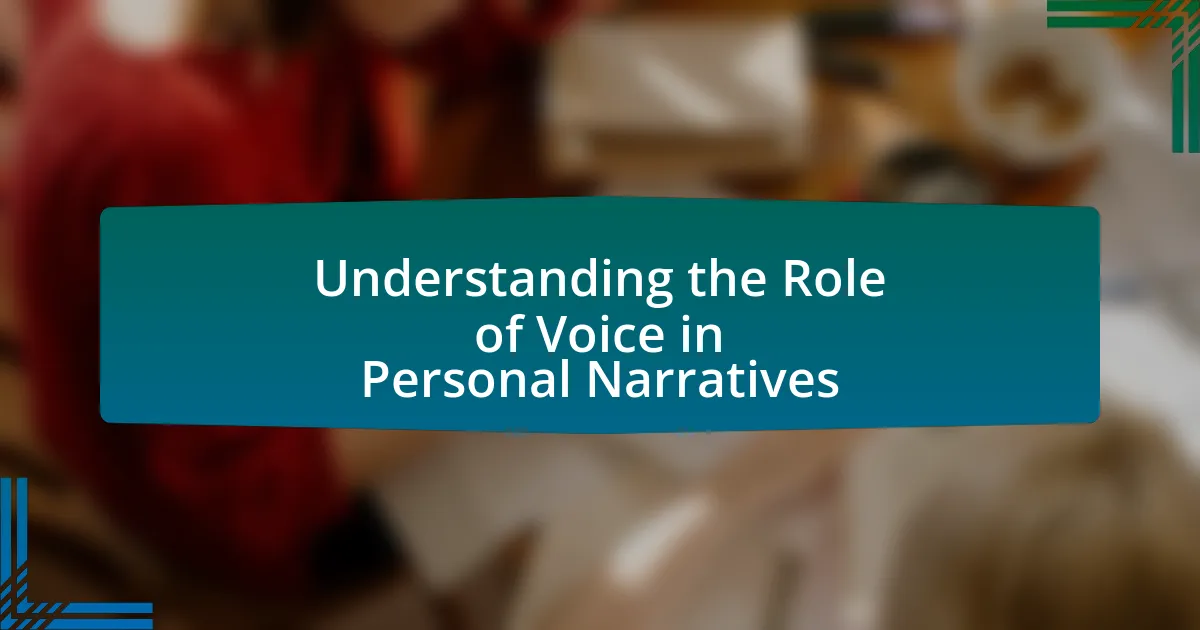The article focuses on the role of voice in personal narratives, emphasizing its significance in conveying the author’s unique perspective and emotional truth. It explores how voice influences storytelling through elements such as tone, diction, syntax, and perspective, shaping the reader’s connection to the narrative. Additionally, the article discusses how an author’s background impacts their voice, the importance of authenticity, and the different types of narrative voices, including first-person and third-person perspectives. It also addresses strategies for writers to enhance their voice, overcome challenges, and effectively engage readers through vivid imagery and consistent tone.

What is the Role of Voice in Personal Narratives?
The role of voice in personal narratives is to convey the author’s unique perspective and emotional truth, shaping the reader’s understanding and connection to the story. Voice encompasses tone, style, and personality, which together create an authentic representation of the author’s experiences. For instance, a study by McAdams (2001) highlights that personal narratives are often shaped by the storyteller’s voice, influencing how life events are interpreted and understood. This demonstrates that voice is not merely a stylistic choice but a crucial element that impacts the narrative’s effectiveness and resonance with the audience.
How does voice influence the storytelling process in personal narratives?
Voice significantly influences the storytelling process in personal narratives by shaping the emotional tone and authenticity of the narrative. The unique voice of the storyteller conveys personality, perspective, and emotional depth, which engages the audience and fosters a connection. For instance, a first-person narrative that employs a conversational tone can create intimacy, allowing readers to relate more closely to the experiences shared. Research indicates that narratives with a strong, distinct voice are more memorable and impactful, as they resonate with readers on a personal level, enhancing their understanding and empathy towards the storyteller’s experiences.
What are the different elements that constitute voice in writing?
The different elements that constitute voice in writing include tone, diction, syntax, and perspective. Tone refers to the writer’s attitude toward the subject, which can evoke specific emotions in the reader. Diction involves the choice of words and phrases, influencing the clarity and style of the writing. Syntax pertains to the arrangement of words and sentence structure, affecting the rhythm and flow of the narrative. Perspective, or point of view, shapes how the story is told and can significantly impact the reader’s connection to the narrative. Each of these elements works together to create a unique voice that reflects the writer’s personality and intent.
How does the author’s background shape their voice?
The author’s background significantly shapes their voice by influencing their perspectives, experiences, and cultural context. For instance, an author raised in a multicultural environment may incorporate diverse linguistic styles and themes, reflecting their unique identity and experiences. This is evident in the works of authors like Chimamanda Ngozi Adichie, whose Nigerian heritage informs her narrative style and thematic choices, allowing her to convey complex cultural realities. Such background elements contribute to the authenticity and relatability of the author’s voice, making it resonate with readers who share similar experiences or seek to understand different perspectives.
Why is voice important in conveying personal experiences?
Voice is important in conveying personal experiences because it reflects individuality and authenticity, allowing the storyteller to express emotions and perspectives uniquely. A distinct voice engages the audience, fostering a deeper connection and understanding of the narrative. Research indicates that narratives delivered with a strong personal voice are more memorable and impactful, as they resonate emotionally with listeners, enhancing empathy and relatability. For instance, studies in psychology show that personal storytelling can significantly influence how experiences are perceived and understood, emphasizing the critical role of voice in shaping personal narratives.
How does voice affect the emotional impact of a narrative?
Voice significantly affects the emotional impact of a narrative by shaping the tone, perspective, and authenticity of the storytelling. A distinct voice can evoke specific emotions in the audience, as it conveys the narrator’s feelings and intentions, influencing how the story is perceived. For instance, a first-person narrative with a reflective voice can create intimacy and empathy, allowing readers to connect deeply with the narrator’s experiences. Research indicates that narratives delivered in a conversational tone can enhance emotional engagement, as demonstrated in studies by Green and Brock (2000), which show that immersive storytelling increases emotional responses. Thus, the choice of voice is crucial in determining how effectively a narrative resonates emotionally with its audience.
What role does voice play in establishing authenticity?
Voice plays a crucial role in establishing authenticity by conveying an individual’s unique perspective and emotional truth. When a person expresses themselves through their voice, whether in writing or speaking, it reflects their personality, values, and experiences, which fosters a genuine connection with the audience. Research indicates that authenticity is perceived when the voice aligns with the content, as seen in studies showing that audiences respond positively to narratives that resonate with personal experiences and emotions. This alignment enhances credibility and relatability, reinforcing the notion that a true voice is essential for authentic communication.

What are the Different Types of Voice in Personal Narratives?
The different types of voice in personal narratives include first-person, second-person, and third-person perspectives. First-person voice uses “I” or “we,” allowing the narrator to share personal experiences and emotions directly, creating intimacy with the reader. Second-person voice employs “you,” engaging the reader as a participant in the narrative, which can create a unique immersive experience. Third-person voice utilizes “he,” “she,” or “they,” providing a broader perspective that can encompass multiple characters and viewpoints, allowing for a more objective storytelling approach. Each type of voice serves distinct purposes in conveying the narrator’s perspective and shaping the reader’s experience.
How do first-person and third-person voices differ in personal narratives?
First-person and third-person voices differ in personal narratives primarily in perspective and intimacy. First-person voice uses “I” or “we,” allowing the narrator to share personal thoughts, feelings, and experiences directly, creating a sense of closeness and immediacy. In contrast, third-person voice employs “he,” “she,” or “they,” which provides a more detached viewpoint, allowing for broader observations and insights into multiple characters’ experiences without the same level of personal connection. This distinction affects how readers engage with the narrative; first-person can evoke empathy and personal identification, while third-person can offer a more objective analysis of events and characters.
What are the advantages of using a first-person voice?
Using a first-person voice enhances personal narratives by creating intimacy and authenticity. This perspective allows the writer to share personal experiences and emotions directly, fostering a deeper connection with the reader. Research indicates that first-person narratives can increase engagement, as readers often feel more involved in the story when they perceive it through the eyes of the narrator. Additionally, first-person voice can provide unique insights into the narrator’s thoughts and feelings, making the narrative more relatable and impactful.
In what contexts is a third-person voice more effective?
A third-person voice is more effective in contexts that require objectivity, distance, and a broader perspective. This narrative style allows the writer to present multiple viewpoints and insights, making it suitable for analytical writing, academic research, and storytelling that involves complex character dynamics. For instance, in literary works like “The Great Gatsby” by F. Scott Fitzgerald, the third-person perspective enables readers to understand the motivations and backgrounds of various characters, enhancing the narrative’s depth. Additionally, in academic contexts, using a third-person voice helps maintain an impartial tone, which is essential for credibility and objectivity in research papers and reports.
What are the characteristics of a strong narrative voice?
A strong narrative voice is characterized by authenticity, clarity, and distinctiveness. Authenticity ensures that the voice resonates with the reader, reflecting genuine emotions and experiences, which fosters a connection. Clarity allows the narrative to be easily understood, guiding the reader through the story without confusion. Distinctiveness sets the voice apart, often achieved through unique language, tone, and style that reflect the narrator’s personality. These characteristics are essential for engaging the audience and enhancing the overall impact of the narrative.
How does tone contribute to the strength of a narrative voice?
Tone significantly enhances the strength of a narrative voice by establishing the emotional atmosphere and guiding the reader’s perception of the story. A consistent tone, whether it is humorous, somber, or reflective, shapes how readers connect with characters and events, influencing their engagement and empathy. For instance, a narrative with a sarcastic tone can create a sense of irony, while a sincere tone fosters trust and authenticity. Research indicates that tone affects reader interpretation; a study published in the Journal of Language and Social Psychology found that tone can alter the perceived credibility of a narrative, demonstrating its critical role in effective storytelling.
What techniques can writers use to develop a unique voice?
Writers can develop a unique voice by employing techniques such as experimenting with sentence structure, utilizing specific word choices, and incorporating personal experiences. By varying sentence length and complexity, writers can create rhythm and emphasis that reflect their individuality. Choosing precise and evocative words allows for a distinct tone that resonates with readers, while integrating personal anecdotes adds authenticity and relatability to the narrative. These methods collectively contribute to a recognizable and engaging voice, essential for effective personal storytelling.

How Can Writers Enhance Their Voice in Personal Narratives?
Writers can enhance their voice in personal narratives by employing authentic language and incorporating personal experiences. Authentic language allows writers to express their unique perspectives and emotions, making their narratives relatable and engaging. For instance, using colloquial expressions or regional dialects can create a sense of place and identity, which strengthens the connection with readers. Additionally, integrating specific personal experiences, such as vivid memories or detailed anecdotes, adds depth and authenticity to the narrative. Research indicates that narratives rich in personal detail resonate more with audiences, as they evoke empathy and understanding, thereby reinforcing the writer’s voice.
What practices can help writers discover their authentic voice?
Writers can discover their authentic voice through consistent journaling, reading widely, and engaging in free writing. Journaling allows writers to express thoughts and emotions without judgment, fostering a personal style. Reading diverse genres exposes writers to various voices and techniques, helping them identify what resonates with their own expression. Free writing encourages spontaneity and creativity, breaking down barriers of self-censorship. These practices collectively enhance self-awareness and confidence, essential for developing a unique voice in personal narratives.
How does reading widely influence a writer’s voice?
Reading widely enhances a writer’s voice by exposing them to diverse styles, perspectives, and techniques. This exposure allows writers to assimilate various elements of language, structure, and tone, which they can then incorporate into their own writing. For instance, a study by the University of California found that writers who read a variety of genres develop a more nuanced understanding of narrative voice, enabling them to create more authentic and engaging characters. Consequently, the breadth of reading not only enriches vocabulary but also fosters creativity and adaptability in a writer’s unique expression.
What role does feedback play in refining a writer’s voice?
Feedback plays a crucial role in refining a writer’s voice by providing external perspectives that highlight strengths and areas for improvement. This external input allows writers to identify inconsistencies in tone, style, and clarity, which are essential for developing a unique voice. For instance, studies show that writers who actively seek and incorporate feedback tend to produce more authentic and resonant narratives, as they can adjust their expression based on reader reactions. By engaging with feedback, writers can better align their voice with their intended message, ultimately enhancing the effectiveness of their personal narratives.
What common challenges do writers face in developing their voice?
Writers commonly face challenges such as self-doubt, lack of clarity, and the influence of external expectations when developing their voice. Self-doubt can hinder a writer’s confidence in expressing their unique perspective, leading to a struggle in finding authenticity. Lack of clarity often results from not fully understanding their own thoughts and feelings, making it difficult to convey a consistent voice. Additionally, external expectations from audiences or publishers can pressure writers to conform to certain styles, which may dilute their personal voice. These challenges are well-documented in writing studies, highlighting the importance of self-exploration and authenticity in voice development.
How can writers overcome self-doubt regarding their voice?
Writers can overcome self-doubt regarding their voice by actively engaging in regular writing practice and seeking constructive feedback. Consistent writing helps to build confidence and familiarity with one’s unique style, while feedback from trusted peers or mentors provides validation and insights that can enhance a writer’s sense of authenticity. Research indicates that writers who participate in workshops or writing groups report increased confidence in their voice due to the supportive environment and shared experiences (Perrin, 2020, “The Impact of Writing Groups on Writer Confidence,” Journal of Creative Writing Studies). This combination of practice and community support effectively diminishes self-doubt and fosters a stronger, more distinct voice in personal narratives.
What strategies can help writers avoid clichés in their voice?
Writers can avoid clichés in their voice by employing strategies such as using specific imagery, developing a unique perspective, and engaging in active reading. Specific imagery allows writers to create vivid and original descriptions that resonate with readers, moving away from overused phrases. Developing a unique perspective involves reflecting on personal experiences and insights, which fosters authenticity and originality in writing. Engaging in active reading helps writers identify clichés in others’ work, enabling them to recognize and avoid similar pitfalls in their own writing. These strategies collectively enhance a writer’s voice, making it more distinctive and impactful.
What are some best practices for using voice effectively in personal narratives?
To use voice effectively in personal narratives, writers should adopt a consistent tone that reflects their personality and experiences. This consistency helps create a strong connection with the audience, making the narrative more relatable and engaging. Additionally, incorporating vivid imagery and sensory details enhances the voice, allowing readers to immerse themselves in the story. Research indicates that narratives with a strong, authentic voice can evoke emotional responses, as demonstrated in studies on storytelling and empathy, such as those conducted by Paul Zak, which highlight the impact of narrative on emotional engagement.



